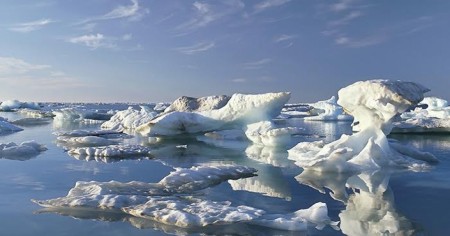February 21, 2016 – Not even the climate models could have predicted what happened in January 2016 in the Arctic. Data from NASA and the National Oceanic and Atmospheric Administration (NOAA) showed an overall warm month in the Northern Hemisphere. But at the North Pole the average temperature was 4 Celsius (7.2 Fahrenheit) degrees warmer than averages recorded between 1951 and 1980.
This shouldn’t be a surprise that the poles are most impacted by the rise in carbon in the atmosphere. All the climate models have indicated this. But it is the degree and speed of warming that has exceeded any model. Accompanying the warmth is a new record low for Arctic sea ice, the lowest since satellite records began in 1979. Normally January is an ice building month on the Arctic Ocean but satellite data shows sea ice levels decreasing amounting to over 1,000,000 square kilometers (400,000 square miles) below the 1981 to 2010 average.
When you hear scientists such as Mark Serreze, the Director of the U.S. National Snow and Ice Data Center, describing the conditions as “absurdly warm” you know something is cooking, and it appears it is our planet. The conditions, apparently, are persisting into February and that means by summer and fall when the ice melt is at its greatest extent, conditions will be “starting out in a deep hole.”
Is this just carbon dioxide (CO2) in the atmosphere that is the cause? The El Nino in the Pacific and the warm blob in the northeast Pacific are seen to be mitigating factors. These bodies of warm water, accompanied by a cool blob in the North Atlantic, have changed the course of the Jet Stream. But Serreze sees the strong El Nino and other phenomena as causally linked to rising CO2.
In any event, this winter will probably be studied to death by climatologists because it may be the beginning of a trend which could see Arctic permafrost thaw in conjunction with low sea ice levels further accelerating the warming.
Here’s a quick summary of what happened on land across the globe in January. Land surface temperature were 1.56 Celsius (2.81 Fahrenheit) above average. Northern Siberia recorded average temperatures at least 5 Celsius (9 Fahrenheit) above the 1981–2010 monthly average. Similarly, parts of southeastern Asia, southwestern Asia, the Middle East, Southern Africa, and areas of Central and South America were also much warmer than average. Northern Mexico, Scandinavia, parts of Central Asia around Mongolia and China experienced temperatures 5 Celsius (9 Fahrenheit) below normal. Parts of Australia, Tasmania in particular, recorded the highest mean average temperature since 1961. And at the South Pole, a reversal in sea ice growth was noted with a reduction of 4.3% below the average recorded between 1981 and 2010. Declining Southern Ocean sea ice reverses a trend that has seen that part of the world the only place seemingly unaffected by climate change.
What should the world expect as 2016 unfolds? NOAA’s Climate Prediction Center believes the El Nino will weaken and possibly transition to a La Nina by the coming fall. That may reverse the warming trend in the Arctic but some scientists are speculating that we may have reached the tipping point with no appreciable going back for the foreseeable future.




















